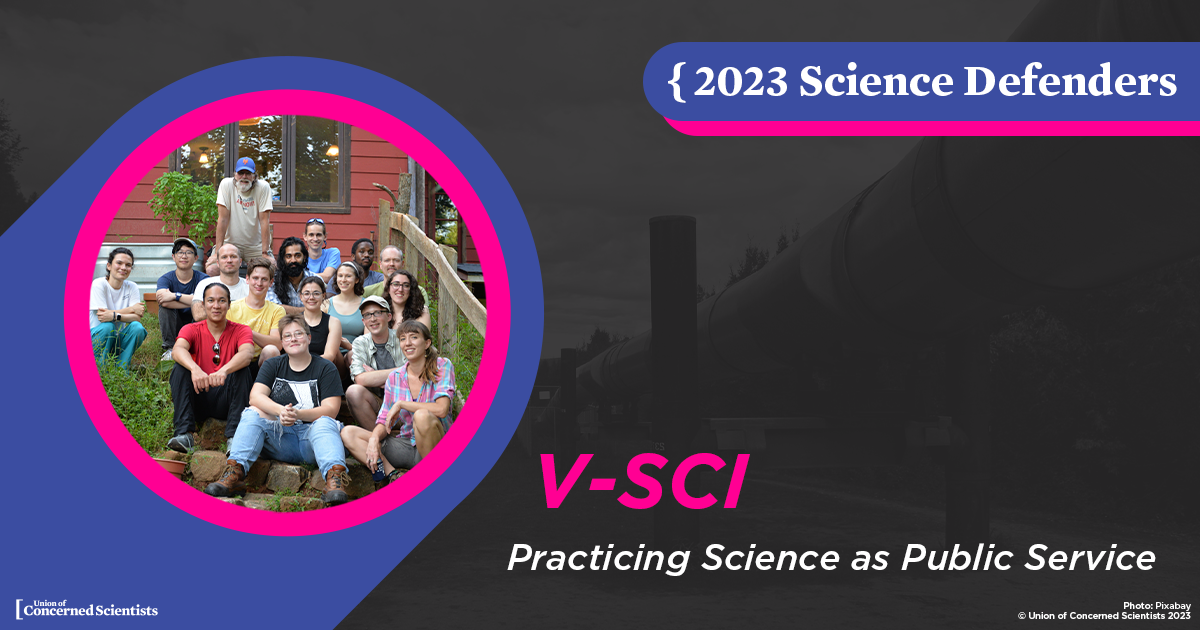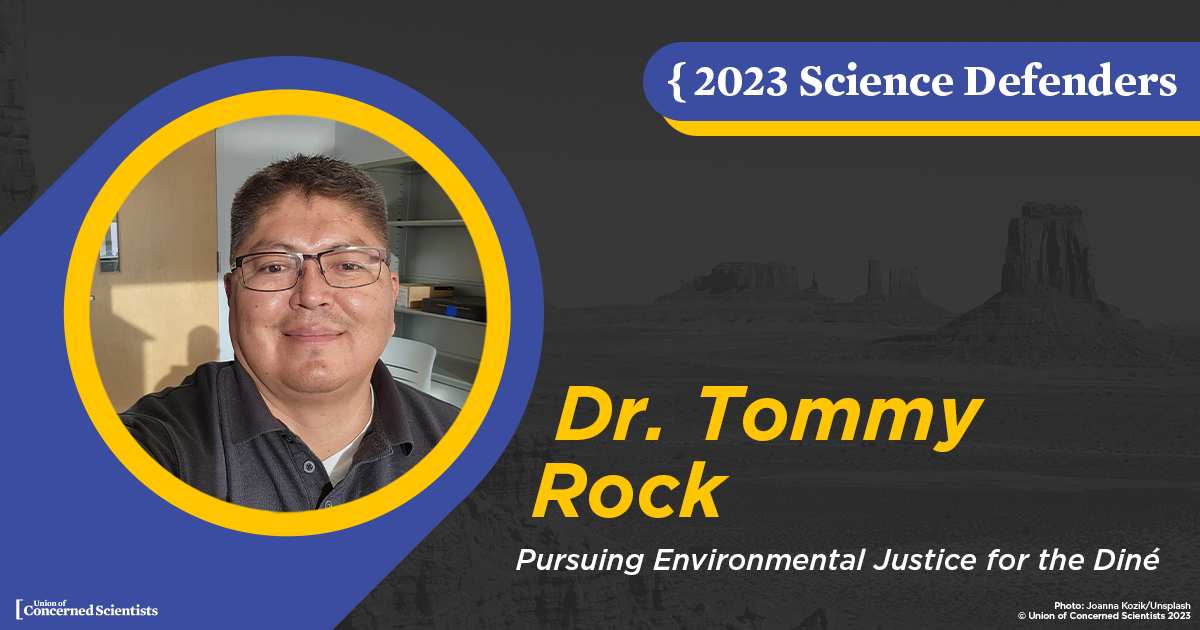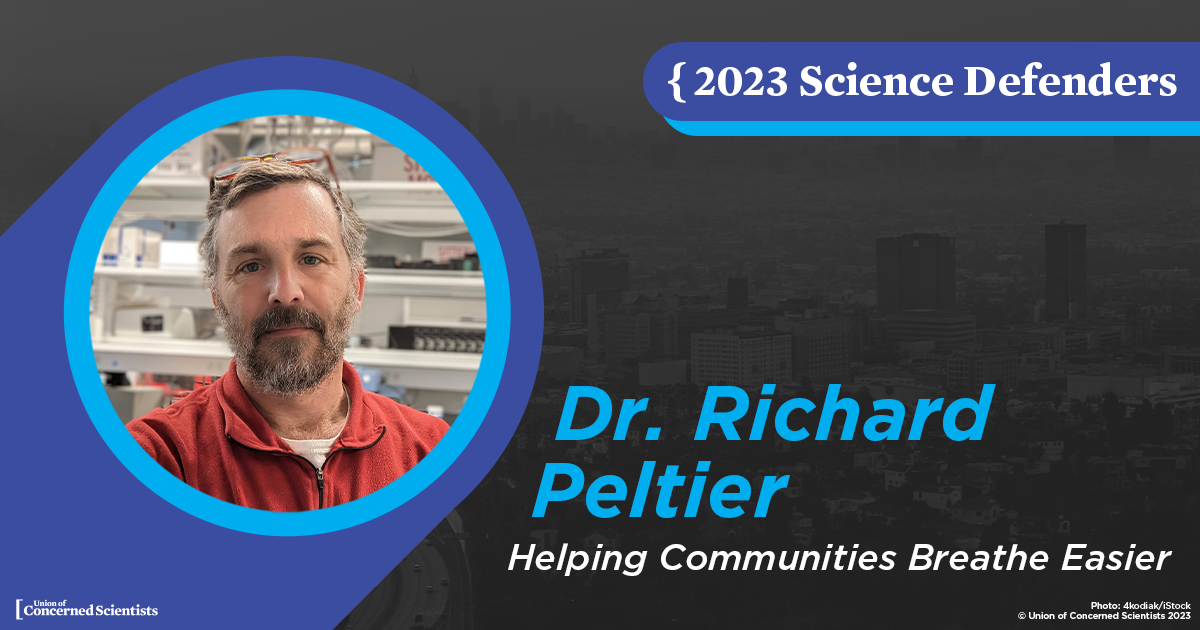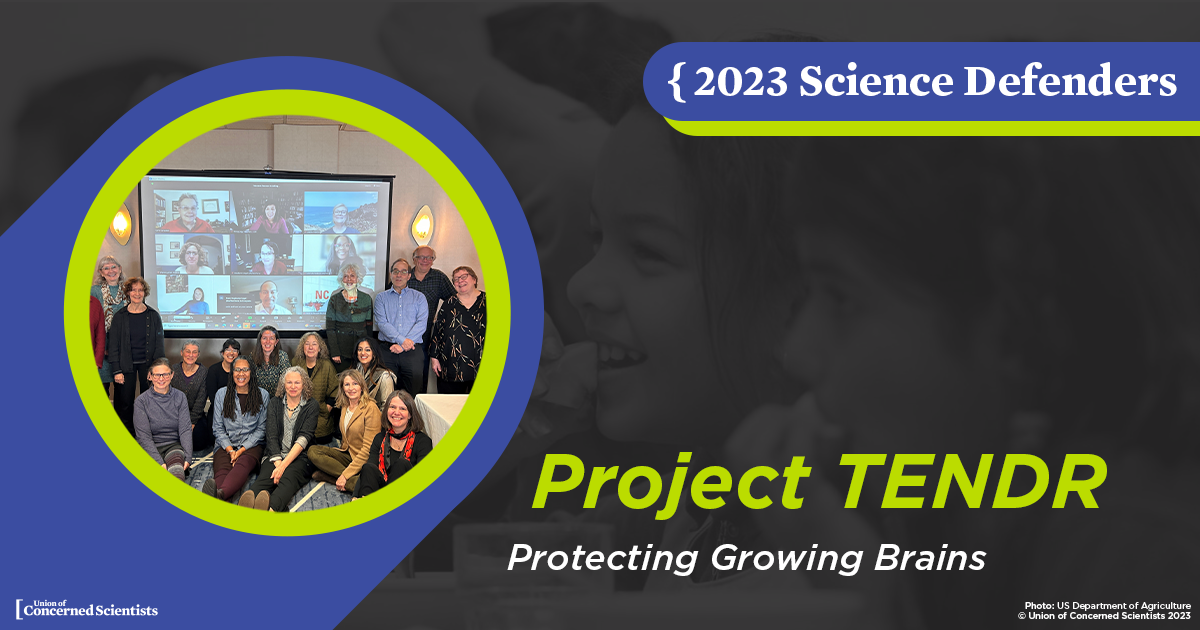Every year, the Union of Concerned Scientists celebrates several individuals and/or groups who have done outstanding work to defend science, or who have put science to work to help people and change the world for the better. The 2023 UCS Science Defenders share a special commitment to leverage science to help their communities. We are so pleased to introduce them, and their great work.

V-SCI: Practicing Science as Public Service
Launched in 2020 by graduate students from the University of Virginia and Virginia Tech, the Virginia Scientist-Community Interface, or V-SCI, is an independent group of scientists who volunteer their time and expertise to help address local issues. In the short time V-SCI members have been working together, the organization has ballooned to include early-career scientists, postdocs, and others, from different universities and institutions. “We’ve recruited and expanded our reach,” says Hannah Mast, president of V-SCI and a PhD student at UVA.
Today, V-SCI’s members work in teams and in partnership with local organizations on projects as disparate as analyzing unequal energy costs among residents of Charlottesville, and protecting the habitat of a hyper-local endangered species of fish. Each of the group’s projects is designed so that team members can “provide science for community issues that matter,” Mast says, and apply their knowledge and skills to real-world problems. “As a grad student, I sometimes felt that our science could support meaningful change in the world—but there was a disconnect,” she says. “It just didn’t go anywhere. Once I found V-SCI, it felt like exactly what I’d been looking for. It was meaningful from the beginning.”
At its inception, V-SCI took on one project that turned out to be a real David v. Goliath battle: to make the science-based case that a natural gas pipeline should not be permitted to run through Virginia’s Jefferson National Forest. V-SCI successfully proved that the pipeline company’s planning documents contained technical flaws and would create much more environmental degradation than the company had estimated. The US Court of Appeals for the Fourth Circuit agreed, citing their evidence and rejecting the permit. Unfortunately, the pipeline was fast-tracked anyway, through a rider in federal legislation. Now V-SCI has pivoted to watchdogging the pipeline, reviewing its engineering and environmental mitigation plans, and preparing to weigh in on the regulatory process for a proposed extension.
Mast stresses that V-SCI is, above all, a team effort—not just within the group, but with their local partners. “A lot of the people we work with are real grassroots advocates who know the community well, and the issues that they need support with,” she says. “They really help us stay grounded in what the community means.”

Dr. Tommy Rock: Pursuing Environmental Justice for the Diné
From the start of the atomic age to the end of the Cold War, mining companies operated uranium mines in Navajo Nation, employing tribal members for the dangerous work while providing few if any protections for their health and safety, and insufficient information about the risks to people nearby. When demand waned for US-mined uranium—used for nuclear power and weapons—many companies abandoned their mines, leaving the Navajo/Diné people with the fallout, including contaminated water, soil, and air. The Environmental Protection Agency estimates there are more than 500 abandoned uranium mines in and near Navajo Nation; these mines leach contaminants into water sources and the soil, creating dangerous air quality when it’s picked up by wind, and polluting crops like corn and squash.
Dr. Tommy Rock, assistant research professor at Northern Arizona University and a member of the Navajo/Diné tribe, uses his doctorate in Earth science and environmental sustainability and his position in academia to help identify and remediate air, soil, and water contamination in Navajo/Diné communities. “My late grandfather was a former uranium miner, and he died of cancer,” he says. “As I got into this research, I saw some of my peers from high school and undergrad pass away as well, because of this exposure.”
Earlier in his career, Dr. Rock successfully raised enough awareness of uranium contamination in the public drinking water in the town of Sanders, Arizona—where most of the residents are Native American—that the state and Navajo Nation allowed the town to switch to another water provider.
“I’m trying to improve the quality of life for rural, isolated communities, while also preserving our traditional way of life, and empowering people,” he says. He’s still conducting research in Sanders and other communities, to study solutions for soil and water contamination, and is also helping to provide access to drinking water, which he explains is limited in isolated rural communities in Navajo Nation.
“This work is personal,” says Dr. Rock. “I understand the frustration community members are going through. There’s a flaw in our capitalist society: it exploits our resources and health, and that exploitation benefits the wealthy and corporations, not the people. I know I'm not the only person that's working on this, but I'm happy to help contribute and try to make a difference.”

Dr. Richard Peltier: Helping Communities Breathe Easier
In each of his classes at the University of Massachusetts Amherst, where he’s a professor of environmental health sciences, Dr. Rick Peltier shares this quote from Albert Einstein: “Those with the privilege to know have the duty to act.” This philosophy guides him in his research on air pollution and its effects on our health: he and his team work with people living with unsafe air quality to improve public health, and share their findings and recommendations with the communities they’re studying. “I realized that we as academics have this information that's really important for people, but we tend to publish to our narrow body of friends and colleagues who already think and act like us. And we don’t often connect our research to the broader public—and that really bothered me,” Dr. Peltier says. “My job as an academic is to serve others and provide them with at least some guidance on the complicated bits of science that they need to improve their well-being in their community.”
Dr. Peltier helps collect and interpret data on air quality around the world, especially in the Global South, where he says he can make a big difference by identifying sources of air pollution and suggesting relatively easy ways to reduce people’s exposure. His team works in countries such as Nepal and Bolivia, “where there are air pollution problems that are not being seen, observed, or interrogated,” he says. “We choose to spend intellectual capital on those populations because they have lungs just like everybody else.” Closer to home, he’s worked with grassroots environmental justice organizations in Kansas, Texas, and Tennessee to help them make the scientific case for limiting emissions of ethylene oxide, a carcinogenic gas released by certain industrial facilities.
Dr. Peltier says it’s important to him to listen to communities and modify his research to meet their needs. Anything else, he says, is colonial science. “It might get you a new paper you could publish, but it’s not the right thing to do. You have to give people the tools to do this work on their own, because they continue to live there whether you’re there or not.” To fellow scientists who wish to pursue similar community-based research, he advises: “Listen first and talk last; make sure your ears are bigger than your mouth.”

Project TENDR: Protecting Growing Brains
About ten years ago, as evidence piled up about negative effects from neurotoxins and pollutants on children’s developing brains, many researchers and advocates were growing increasingly frustrated by policymakers’ lack of action to address the problem. Over dinner at a conference, the idea for Project TENDR was born: an organization of scientists, health professionals, and advocates who would work together to amplify their research and recommend policy solutions. “From its inception, we saw Project TENDR as a way to bring scientific evidence to bear on policy decisions to prevent harm to children’s learning and development,” say its three leaders, Maureen Swanson of The Arc, Dr. Irva Hertz-Picciotto from the University of California, Davis, and Dr. Tanya Taiwo, from Bastyr University in Washington state. When they reached out to others in the field, nearly everyone they contacted agreed to join. “The time was right for Project TENDR,” the team says. Today, Project TENDR has more than 50 members, several victories for children’s brain health under their belts, and seven peer-reviewed articles published in medical and scientific journals. These articles are difficult to ignore since they are written through scientific consensus—and provide evidence to support public comments and other input on rules to limit exposure to various pollutants.
“Our most meaningful achievements result when we offer scientific expertise and insights that no one else can, such as on the neurological effects of even tiny amounts of exposures,” the team says. “For example, Project TENDR played a key role in winning restrictions on a terrible pesticide widely used on fruits and vegetables. And we recently had a major influence on a series of federal initiatives around eliminating lead exposure, which is one of our long-held goals.”
Next up for Project TENDR: working to end racial and socioeconomic disparities in exposure to dangerous chemicals; they recently published a paper on this topic. “For every chemical our researchers examined—lead, air pollutants, organophosphate pesticides, phthalates—children of color or in poverty were more highly exposed and suffered greater harm,” they say. And they plan to advocate for the Food and Drug Administration to issue a federal ban on phthalates in food packing and processing, after publishing a consensus paper documenting the neurotoxicity of this group of chemicals. “The evidence of harm is overwhelming,” the team says.